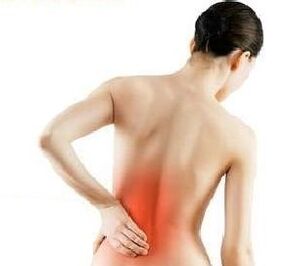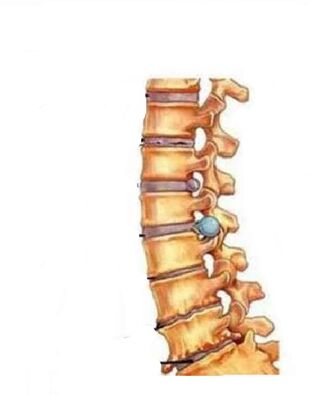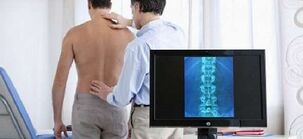Every year, the number of patients who go to medical institutions for help complain of back pain. If you do not even perform a lot of physical activity on the skeleton, your activity consists of a sedentary lifestyle - at night, your back still hurts.
Why is this happening and how to eliminate the constant discomfort?
The causes of back pain can be hidden in a number of pathologies. If you have an unpleasant sensation in your lower back, see a neurologist immediately. Back pain and persistent discomfort can lead to limited mobility and decreased activity.
In most situations, the cause that causes back pain can lie in ailments of the spine, ailments of vital organs, as a result of professional activity, birth trauma. Only an experienced specialist can make an accurate diagnosis after an examination. In some situations, a number of additional diagnostic measures are prescribed.
According to statistics, back pain affects 50% of the world's population.
At the same time, in childhood, this phenomenon is a sign of pathologies of internal organs that occur infrequently. In most cases, back pain affects elderly patients.
Pathogenesis of occurrence

As a general rule, the causes of back pain are associated with musculoskeletal defects. Less common pathogenesis, which lies in serious violations of the elements of the skeleton. Also, at certain points, back pain can be triggered by the most dangerous ailments. Such as tumors and inflammations in the spinal cord, pathologies of important organs for life: the heart, the liver and the like.
And then, the reason:
- The gestation period.
- Scoliosis.
- Pelvic hemorrhage.
- Aortic injury.
- Entry of infectious parasites into the muscle tissue of the spine and pelvis.
- The spread of malignant neoplasms to the back.
- Postponed ailments of an infectious nature. For example, FLU.
- Multiple injuries.
The reason why it hurts
it may be the presence of certain diseases:- osteochondrosis;
- radiculitis;
- intervertebral hernia;
- bone cancer;
- fractures;
- sciatica and a wide range of other disorders.
Osteochondrosis
Back pain in osteochondrosis is painful in nature. In addition, its symptoms are a cracking in the spine, an unpleasant sensation in the lumbar region. After a certain time, numbness appears in the pathology zone. This limits movement. Back pain is more pronounced with exercise.
It also appears brighter when coughing, sneezing, or any sudden movement. The "hell pain" lurks due to compression of the nerve endings by the discs.
Back pain can last from several minutes to a day. If the disease has spread to the chest, unpleasant sensations appear in the heart organ. Therefore, patients do not always guess the disease, thinking that they have angina. If you do not start treatment in time, osteochondrosis becomes chronic. The patient cannot stand or sit for a long time, he tires quickly, he always wants to lie down.

3/4 of the population that develops symptoms of acute back pain suffers from precisely this disease. Also, the disease affects people over thirty years of age. This is due to the fact that the years go by, the human spine wears out and becomes susceptible to various pathologies.
If your back hurts and you suspect osteochondrosis, you should make an appointment with a neurologist. He will take diagnostic measures to make an accurate diagnosis, prescribe special medications, prescribe physical therapy exercises and put you on the necessary diet.
Radiculitis
Back pain can form with an ailment such as sciatica. This disease is the result of compression of the nerve endings, as a result of which changes of a different nature occur. All this accompanies back pain, which occurs quite often.
The syndrome manifests itself at the site of the disease. It can be permanent or temporary. Pain can radiate to arms and legs. In addition, the muscle mass weakens and the limbs go numb.
Herniated disc
During the early stage of disease development, back pain is dull in nature. It becomes more when bending, turning, sudden movements. Often lethargy can appear in one of the lower extremities.
After a certain period, the back pain starts to get worse. As a result, there is a strong overexertion of the muscles. This contributes to limitation of movement. As a result, the patient's posture changes noticeably for the worse. As a rule, this pathology is formed in patients after forty years. At a younger age, it manifests itself as a result of injury.
This disease should be treated in the early stages of its development. You should seek the help of an orthopedist or neurologist. As a general rule, the doctor uses CT to diagnose this pathology. As therapy, they resort to surgical intervention.
Diagnostic activities

If persistent and severe back pain makes life difficult for you, go to the hospital.
First, the specialist performs an examination by palpating the muscle tissue and skeleton of the spine. It also assesses the state of the central nervous system. The second step will be the laboratory tests of blood and urine. This is necessary to eliminate the probability of pathology in the kidney organ.
Radiography is used as an additional diagnostic measure. This is necessary to eliminate the likelihood of fractures of various types, osteomyelitis and a number of other ailments.
If the radiograph shows ambiguous results, an additional CT scan and MRI of the spine are prescribed. The CT scan clearly shows all the elements of the spinal skeleton and the MRI, the condition of the spinal cord and discs.
When carrying out the listed diagnostic methods, the presence of osteochondrosis is often revealed. It can't even be called a disease, but rather age-related spinal changes.
During diagnostic measures, in most cases, certain diseases that form with age are found. Pathologies can reveal themselves even if the patient has never experienced back pain. Based on the results of a complete diagnosis, a highly qualified specialist makes a diagnosis and prescribes effective treatment.
Pain therapy
In order for the pain syndrome to leave you alone forever, you must eliminate the cause of its occurrence. That is, you will be cured of the disease that causes this pain. A neurologist or an orthopedist selects individual therapy methods for each case.
But the treatment of all kinds of pathologies is associated with cupping, acupuncture and manual therapy.

Pain Relief
As a general rule, pain in any disease subsides when the patient lies down. But this is not recommended. When a person spends most of the time lying down, the disease begins to develop at a faster rate.
For certain types of pathologies, a specialist prescribes adherence to bed rest. The doctor's recommendations, of course, should be followed, but try to shorten this period of time as much as possible. The earlier you get out of bed, the more beneficial it will be for your healing.
Also don't overload the column. During that period while tormented by pain, try to avoid physical exertion and wear a special medical corset for fixation.
Pain relief includes conservative influencing methods. The specialist prescribes drugs for oral administration, as well as for injections. Usually nonsteroidal anti-inflammatory drugs are prescribed, such as diclofenac, lornoxicam.
Muscle relaxants are also used: tizanidine and tolperisone hydrochloride. When dystrophic processes occur, chondroprotectors are used. The doctor may prescribe topical ointments and gels, which belong to the group of non-steroidal anti-inflammatory drugs.
After a thorough examination and accurate diagnosis, the physician may recommend physical therapy, which consists of warming up with dry heat. As well as a set of exercises for physiotherapy exercises.
Manual therapy
If this treatment method is performed by a qualified manual operator in accordance with all rules and regulations, the pain syndrome will disappear in the shortest possible time. In addition, manual therapy helps eliminate vertebral defects.
This treatment should not be used independently, without the permission of the treating specialist. Only after diagnostic measures (X-ray and MRI) have been performed, can the neurologist recommend this method of exposure. This is due to the fact that the therapy has its own contraindications.
Manual therapy should not be used if there is a hernia or if there is a defect in the vertebral discs. It is not recommended for use in cardiovascular pathologies, even after a heart attack or stroke.
Never use this treatment for cancerous tumors.
For thyroid pathologies and osteoporosis, this method is also not recommended. If the disease is in the stage of exacerbation, refrain from manual therapy. And in conclusion, this method of eliminating pain in the spine cannot be used with poor blood clotting.
Acupuncture
Acupuncture is also called acupuncture. This method of treatment is generally used for pain arising as a result of heavy load on the spine or when the patient is in frequent stressful situations.

Experts suggest that acupuncture helps restore endorphins. The effect of these elements in the body is similar to that of morphine. As everyone knows, morphine is a narcotic substance that can completely suppress pain.
Chinese medicine practitioners believe that acupuncture can eliminate pain of any kind.
Still, guided by the research of Russian scientists, acupuncture cannot be used in the following cases:
- with pathologies of the heart organ and its structures;
- for tumors of a malignant and benign nature;
- if you have surgery;
- for ailments of the kidney and liver;
- during pregnancy and during lactation;
- with poor blood clotting;
- in the presence of acute infectious diseases.
Final output
We discovered that back pain and its causes are of diverse nature, the treatment is selected individually for each person. As a general rule, the manifestation of pain is directly related to pathologies of the spine and spinal cord.
Therefore, at the slightest symptom, it is necessary to make an appointment with a specialist neurologist.
As an additional consultation, an examination by a neurosurgeon, rheumatologist, oncologist, pulmonologist, orthopedic surgeon and many other highly qualified specialists will be possible. To understand which doctors are needed, make an appointment with your therapist. He will suggest an additional plan of action.
In addition to the listed specialists, for the treatment and prevention of pain syndrome, they resort to the help of a massage therapist, reflexologist, chiropractor. The most important thing in therapy is not the elimination of the pain defect, but the exclusion of the pathogenesis by which the pain occurs. We can take complex therapy as an example, which consists of two stages.
In the initial stage - the use of a drug that eliminates pain due to its components - vitamin B and diclofenac. Since diclofenac is contained in the drug in trace amounts, it is not capable of causing unpleasant side effects.
The next step is to use the drug, which contains vitamins B1, B6 and B12 in the required amount. Helps to restore the myelin sheath of the fiber, improves the transmission of impulses from nerve endings. It also eliminates pain and prevents its recurrence.
The timely detection of the disease and its treatment is capable of "putting" the patient on their feet in the shortest possible time. The sooner you seek help from medical institutions, the more likely you are to lead a fulfilling life. Any attempt to get rid of the painful effect at home can have irreversible consequences.





































